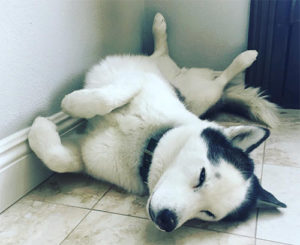
Take a minute to stop and locate your dog. What is he doing? The answer is most likely sleeping. According to the National Sleep Foundation, pups spend between 12-14 hours sleeping each day. And puppies can sleep up to 20 hours a day. While they are snoozing, some dogs whimper, twitch, or bark leaving their humans wondering, do dogs dream? Well, according to science, the answer is an overwhelming yes.

What’s the Deal With Dreaming Dogs?
For humans, dreams are typically very personal. They can give insight into anxieties and wishes. Maybe that’s why many people don’t realize dreams are not unique to humans. In fact, scientists believe all sorts of animals like rats and even fish dream. What should make dogs any different?
Some of the most cited sleep research comes from MIT in 2001. Researchers there trained rats to run a maze and studied their brain activity as they ran it. Later they measured rat brain activity while they were in rapid-eye-movement (REM) sleep. REM is the deepest sleep cycle and the one in which humans dream. The researchers found that during REM sleep, the rat’s brain activity was the same as when the rats were in the maze. This made them conclude the rats were dreaming about the maze.
Find Out How Sharing Some Zzz’s with Your Dog Can Help Relieve Pain!
“No one knew for certain that animals dreamed the way we do, which can involve replaying events or at least components of events that occurred while we were awake,” said Matthew Wilson of MIT’s Center for Learning and Memory. “We looked at the firing patterns of a collection of individual cells to determine the content of rats’ dreams. We know that they are in fact dreaming and their dreams are connected to actual experiences.”
From this, researchers concluded that cats and dogs, who are more intellectually evolved than rats, dream the same way.
According to Stanley Coren, a professor emeritus of psychology at the University of British Columbia, dogs have a very similar dream pattern as humans. Like us, dogs cycle through wakefulness, REM sleep, and non-REM sleep.
A study from Physiological Behavior observed the electrical activity of the brains of six Pointer dogs for 24 hours. The study found the Pointer dogs spent 44% of the time alert, 21% of the time drowsy and 12% in REM sleep. The study also found the dogs spent 23% of their time in slow-wave sleep, the deepest stage of non-REM sleep.
What do we learn from this? Dogs have plenty of time to dream in REM sleep.
What Do Dogs Dream About?
Have you caught your dog twitching, barking, or whimpering while slumbering? Those are signs that your pup is dreaming. Unfortunately, your dog can’t use words to tell you what he was dreaming about, but research has some clues.
The MIT rat research suggested that rats dreamt about their recent activities. Wilson told PetMD, “The dream experiences can be traced back to real experiences. It’s memory that’s being used to synthesize the content of the dreams.” So your dog is probably dreaming about something in their day-to-day activities like running in a park or playing with one of their pals.
With dreams come nightmares. If dogs have such a similar sleep pattern to humans, there is strong evidence to believe they have nightmares like humans. But how can you tell?
Dr. Jennifer Coates, DVM told Dogster, “Determining whether dogs are having nightmares is a bit subjective, but you can sometimes get an idea by watching the way their bodies are moving and the tone of their vocalizations. If what you are observing is similar to what you see and hear when they are awake and upset, they could be experiencing a nightmare.”
Keyword: could. It is impossible to tell with complete certainty the content of your dog’s dream.
Sleep Disorder, Nightmare, or Normal Behavior?
You never want to see your pup in pain. How can you help if your dog is having a nightmare? Dr. Coates says that, as much as it may hurt, you should let your pup dream uninterrupted. She says there are no known negative long-term impacts of nightmares.
There’s no reason to think your dog has a medical condition if she moves or makes noises while sleeping, but if you notice sharp change in behavior, that may be a cause for concern. It is possible for dogs to get narcolepsy or other sleep disorders. If you are worried about your dogs sleeping habits, talk to your pup’s health provider.
Let Sleeping Dogs Lie
As the saying goes, it’s best to let your pup be while they are catching some shut-eye. After all, they need it! When you observe your dog having a dream, there’s no need to wake her. She is in the deepest part of sleep, so let her enjoy catching those Z’s. Don’t be concerned if you find your dog dreaming. Take note if you see major behavior changes and alert the veterinarian if you are concerned.
Otherwise, cuddle up next to your pup and get some rest!
The post Do Dogs Dream? Science Says Yes! appeared first on iHeartDogs.com.
via Whisker Therapy


